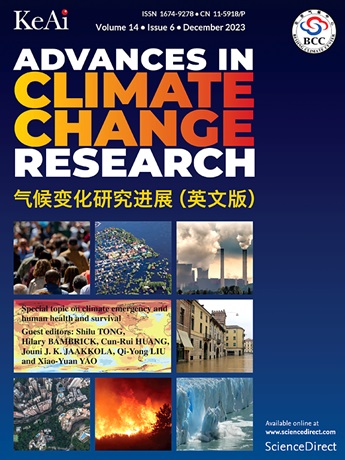Assessing the added value of convection-permitting modeling for urban climate research: A case study in eastern China
IF 5.2
1区 地球科学
Q1 ENVIRONMENTAL SCIENCES
引用次数: 0
Abstract
Accurate urban-resolving climate data are essential for urban climate research and applications. However, General Circulation Models (GCMs) often lack the resolution and urban representation needed to provide reliable fine-scale climate information over urban areas. Convection-permitting modeling (CPM) has emerged as a promising solution to this challenge, despite its computational demands. Evaluating the added value of CPM for specific regions is crucial. In this study, we utilized the Weather Research and Forecasting (WRF) model coupled with a single-layer urban canopy model, as a regional climate model, to assess the performance and added value of CPM at both regional (urban clusters) and local (megacity) scales. With an optimized dynamic downscaling scheme, we conducted 3-km-resolution CPM and 9-km-resolution dynamic downscaling modeling (DDM) during the summer of 2020 in eastern China, where most cities and urban clusters are located. At the local scale, CPM well reproduced observed precipitation rates at daily and sub-daily time scales, greatly improved the overestimation of drizzle-to-light rainfall events and underestimation of heavy-to-torrential rain events in ERA5 reanalysis data. Additionally, CPM effectively captured diurnal variations in precipitation across six sub-regions of eastern China, a capability lacking in DDM and ERA5. Moreover, CPM successfully reproduced the observed urban heat island intensity in Beijing by capturing the heterogeneous air temperature distribution, outperforming ERA5 and DDM. Our findings highlight the considerable added value of CPM in simulating sub-daily precipitation variations and urban heat island intensity over urban areas of China. These insights will greatly enhance future high-resolution regional climate simulations and climate change projections over urban areas in China.
城市气候研究中对流允许模式的附加价值评估:以中国东部地区为例
准确的城市分辨气候数据是城市气候研究和应用的基础。然而,一般环流模式(GCMs)往往缺乏提供可靠的城市地区精细尺度气候信息所需的分辨率和城市代表性。对流允许建模(CPM)已经成为解决这一挑战的一个很有前途的解决方案,尽管它的计算要求很高。评估特定区域CPM的附加值至关重要。在本研究中,我们利用天气研究与预报(WRF)模型和单层城市冠层模型作为区域气候模型,评估了区域(城市群)和地方(特大城市)尺度上CPM的表现和附加值。利用优化后的动态降尺度方案,在中国东部地区开展了2020年夏季3 km分辨率CPM和9 km分辨率动态降尺度模拟(DDM)。在局地尺度上,CPM较好地再现了日和次日时间尺度的观测降水率,极大地改善了ERA5再分析资料中小雨到小雨事件的高估和暴雨到暴雨事件的低估。此外,CPM有效捕获了中国东部6个分区降水的日变化,这是DDM和ERA5所缺乏的能力。CPM通过捕获非均匀的气温分布,成功地再现了北京城市热岛强度,优于ERA5和DDM。研究结果表明,CPM在模拟中国城市地区亚日降水变化和城市热岛强度方面具有相当大的附加价值。这些见解将极大地增强未来中国城市地区的高分辨率区域气候模拟和气候变化预测。
本文章由计算机程序翻译,如有差异,请以英文原文为准。
求助全文
约1分钟内获得全文
求助全文
来源期刊

Advances in Climate Change Research
Earth and Planetary Sciences-Atmospheric Science
CiteScore
9.80
自引率
4.10%
发文量
424
审稿时长
107 days
期刊介绍:
Advances in Climate Change Research publishes scientific research and analyses on climate change and the interactions of climate change with society. This journal encompasses basic science and economic, social, and policy research, including studies on mitigation and adaptation to climate change.
Advances in Climate Change Research attempts to promote research in climate change and provide an impetus for the application of research achievements in numerous aspects, such as socioeconomic sustainable development, responses to the adaptation and mitigation of climate change, diplomatic negotiations of climate and environment policies, and the protection and exploitation of natural resources.
 求助内容:
求助内容: 应助结果提醒方式:
应助结果提醒方式:


